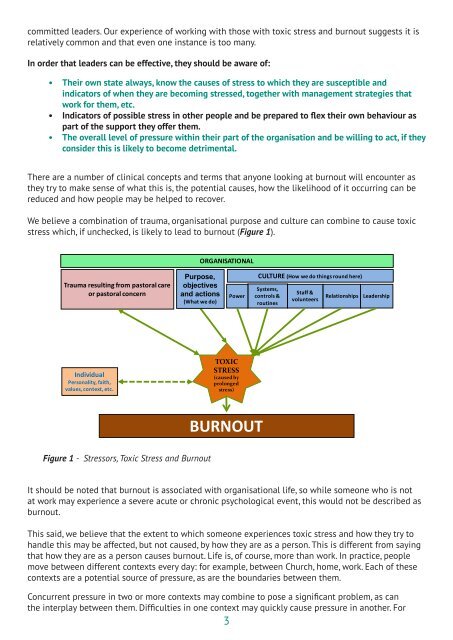Burnout in Churches and Christian Faith-Based Organisations
Burnout is a “syndrome of emotional exhaustion, depersonalization and reduced personal accomplishment that can occur among individuals who work with people in some capacity (Maslach 1996:193). This definition, whilst helpful, fails to convey the potentially life-shattering impact that burnout can have, as described in the words of ‘Peter’, a Christian leader who contributed to this guidance.
Burnout is a “syndrome of emotional exhaustion, depersonalization and reduced personal accomplishment that can occur among individuals who work with people in some capacity (Maslach 1996:193).
This definition, whilst helpful, fails to convey the potentially life-shattering impact that burnout can have, as described in the words of ‘Peter’, a Christian leader who contributed to this guidance.
Create successful ePaper yourself
Turn your PDF publications into a flip-book with our unique Google optimized e-Paper software.
committed leaders. Our experience of work<strong>in</strong>g with those with toxic stress <strong>and</strong> burnout suggests it is<br />
relatively common <strong>and</strong> that even one <strong>in</strong>stance is too many.<br />
In order that leaders can be effective, they should be aware of:<br />
• Their own state always, know the causes of stress to which they are susceptible <strong>and</strong><br />
<strong>in</strong>dicators of when they are becom<strong>in</strong>g stressed, together with management strategies that<br />
work for them, etc.<br />
• Indicators of possible stress <strong>in</strong> other people <strong>and</strong> be prepared to flex their own behaviour as<br />
part of the support they offer them.<br />
• The overall level of pressure with<strong>in</strong> their part of the organisation <strong>and</strong> be will<strong>in</strong>g to act, if they<br />
consider this is likely to become detrimental.<br />
There are a number of cl<strong>in</strong>ical concepts <strong>and</strong> terms that anyone look<strong>in</strong>g at burnout will encounter as<br />
they try to make sense of what this is, the potential causes, how the likelihood of it occurr<strong>in</strong>g can be<br />
reduced <strong>and</strong> how people may be helped to recover.<br />
We believe a comb<strong>in</strong>ation of trauma, organisational purpose <strong>and</strong> culture can comb<strong>in</strong>e to cause toxic<br />
stress which, if unchecked, is likely to lead to burnout (Figure 1).<br />
ORGANISATIONAL<br />
Trauma result<strong>in</strong>g from pastoral care<br />
or pastoral concern<br />
Purpose,<br />
objectives<br />
<strong>and</strong> actions<br />
(What we do)<br />
CULTURE (How we do th<strong>in</strong>gs round here)<br />
Systems,<br />
Staff &<br />
Power controls &<br />
Relationships Leadership<br />
volunteers<br />
rout<strong>in</strong>es<br />
Individual<br />
Personality, faith,<br />
values, context, etc.<br />
TOXIC<br />
STRESS<br />
(caused by<br />
prolonged<br />
stress)<br />
BURNOUT<br />
Figure 1 - Stressors, Toxic Stress <strong>and</strong> <strong>Burnout</strong><br />
It should be noted that burnout is associated with organisational life, so while someone who is not<br />
at work may experience a severe acute or chronic psychological event, this would not be described as<br />
burnout.<br />
This said, we believe that the extent to which someone experiences toxic stress <strong>and</strong> how they try to<br />
h<strong>and</strong>le this may be affected, but not caused, by how they are as a person. This is different from say<strong>in</strong>g<br />
that how they are as a person causes burnout. Life is, of course, more than work. In practice, people<br />
move between different contexts every day: for example, between Church, home, work. Each of these<br />
contexts are a potential source of pressure, as are the boundaries between them.<br />
Concurrent pressure <strong>in</strong> two or more contexts may comb<strong>in</strong>e to pose a significant problem, as can<br />
the <strong>in</strong>terplay between them. Difficulties <strong>in</strong> one context may quickly cause pressure <strong>in</strong> another. For<br />
3



